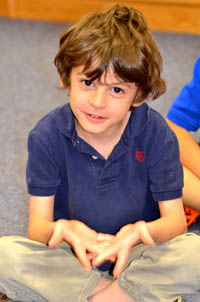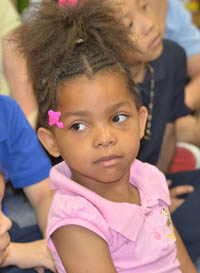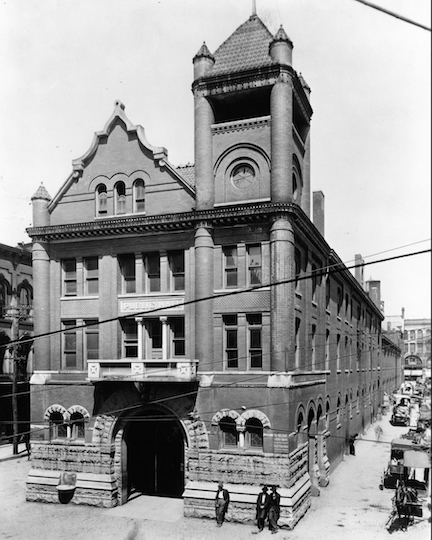Taking It to the Kids
Glencliff Elementary kindergartners review Knuckleball Ned, the new picture book by MLB pitcher R.A. Dickey
Glencliff Elementary, a PreK-4 school which serves the Antioch neighborhood of Nashville, probably doesn’t look much like the same institution that Toronto Blue Jays pitcher R.A. Dickey attended as child during the late 1970s and early 1980s. Built in 1974 during the height of the ill-advised pedagogical craze known as the open classroom—which favored school “rooms” without walls—the Glencliff of R.A. Dickey’s day must have been at least a little chaotic. Today, following extensive renovations, the school is a bright, tidy space where just the barest hum of busy, attentive children can be heard from the other side of closed classroom doors.
 I visited Glencliff because R.A. Dickey, the school’s most famous graduate, has just published a new picture book for children called Knuckleball Ned. It’s not easy to review a picture book, and at Chapter 16 we typically cover those titles by interviewing their authors. The hitch this time is that it’s also not easy to reach R.A. Dickey during baseball season. (With 162 games during the regular season, a MLB baseball team has only a few days off in any given month.) We decided to take his book to its intended audience. What, we wondered, would some kids at his old school say about Knuckleball Ned? After getting the OK from the school system’s central office, Glencliff principal Jeanette Smith and librarian Heather West were game for a visit from Chapter 16.
I visited Glencliff because R.A. Dickey, the school’s most famous graduate, has just published a new picture book for children called Knuckleball Ned. It’s not easy to review a picture book, and at Chapter 16 we typically cover those titles by interviewing their authors. The hitch this time is that it’s also not easy to reach R.A. Dickey during baseball season. (With 162 games during the regular season, a MLB baseball team has only a few days off in any given month.) We decided to take his book to its intended audience. What, we wondered, would some kids at his old school say about Knuckleball Ned? After getting the OK from the school system’s central office, Glencliff principal Jeanette Smith and librarian Heather West were game for a visit from Chapter 16.
 Knuckleball Ned is written for children aged three to six, so I asked to meet with a class of kindergarteners to discuss the book. But because of the large number of English Language Learners at the school, Smith suggested that I read to two classes simultaneously, just to be sure there were enough comments to get a good sense of how the children liked the book and what they learned from it. (The student population at Glencliff is highly diverse, representing twenty-three different nationalities.) I’ve logged some time in kindergarten classrooms as a parent volunteer—after which I invariably had to remind myself that ten o’clock in the morning is too early for a glass of wine—and I had my doubts: Forty wiggling kindergarteners? Some of whom wouldn’t understand the story? I figured the folks at Glencliff must know something about managing five-year-olds that I don’t.
Knuckleball Ned is written for children aged three to six, so I asked to meet with a class of kindergarteners to discuss the book. But because of the large number of English Language Learners at the school, Smith suggested that I read to two classes simultaneously, just to be sure there were enough comments to get a good sense of how the children liked the book and what they learned from it. (The student population at Glencliff is highly diverse, representing twenty-three different nationalities.) I’ve logged some time in kindergarten classrooms as a parent volunteer—after which I invariably had to remind myself that ten o’clock in the morning is too early for a glass of wine—and I had my doubts: Forty wiggling kindergarteners? Some of whom wouldn’t understand the story? I figured the folks at Glencliff must know something about managing five-year-olds that I don’t.
 As planned, West welcomed two different kindergarten classes into the brightly decorated library for story time the morning I arrived with photographer Miller Wild Callen. The children filed in cheerfully and in perfect order, seated themselves in the area West directed them to, and waited absolutely silently for instructions: no shoving, no whispering, no giggling, and not a single impatient wiggle. One little boy looked crestfallen—he later admitted that he had expected R.A. Dickey himself to be conducting this story hour—but otherwise the group was ready to hear about Glencliff’s famous graduate, get a quick tutorial in how baseball works, and hear the story of Knuckleball Ned.
As planned, West welcomed two different kindergarten classes into the brightly decorated library for story time the morning I arrived with photographer Miller Wild Callen. The children filed in cheerfully and in perfect order, seated themselves in the area West directed them to, and waited absolutely silently for instructions: no shoving, no whispering, no giggling, and not a single impatient wiggle. One little boy looked crestfallen—he later admitted that he had expected R.A. Dickey himself to be conducting this story hour—but otherwise the group was ready to hear about Glencliff’s famous graduate, get a quick tutorial in how baseball works, and hear the story of Knuckleball Ned.
 The book, charmingly illustrated by Tim Bowers, features a cast of baseball characters—not baseball players but actual baseballs, each of whom is named for a particular pitch: Sammy Softball, Connie Curveball, Fiona Fastball, and the like. (As she heard the characters’ names, one adorable kindergartner marveled happily, “Fiona is a girl!”) The story begins on the first day of school, and all the children are nervous—everyone except the kids in the Foul Ball Gang, who tease the others and try to trip them as they walk to their seats. The mean kids make fun of Ned for his clumsiness—Knucklehead Ned, they call him—and Sammy for his size, but Ned isn’t intimidated and stands up for Sammy.
The book, charmingly illustrated by Tim Bowers, features a cast of baseball characters—not baseball players but actual baseballs, each of whom is named for a particular pitch: Sammy Softball, Connie Curveball, Fiona Fastball, and the like. (As she heard the characters’ names, one adorable kindergartner marveled happily, “Fiona is a girl!”) The story begins on the first day of school, and all the children are nervous—everyone except the kids in the Foul Ball Gang, who tease the others and try to trip them as they walk to their seats. The mean kids make fun of Ned for his clumsiness—Knucklehead Ned, they call him—and Sammy for his size, but Ned isn’t intimidated and stands up for Sammy.
 Ned has wobbled since birth, but unlike the fastballs and curveballs and sliders in his class, he doesn’t know what kind of ball he is. He only knows that he moves more slowly than the other balls, but he can also float over obstacles when necessary, too. These traits come in handy when the Foul Ball Gang tosses Connie’s ballet shoes into a tree and not one of the other kids can manage to get them down. In saving the day, Ned comes to understand that he’s a knuckleball—the difficult pitch that made R.A. Dickey famous and earned him the National League’s Cy Young Award in 2012.
Ned has wobbled since birth, but unlike the fastballs and curveballs and sliders in his class, he doesn’t know what kind of ball he is. He only knows that he moves more slowly than the other balls, but he can also float over obstacles when necessary, too. These traits come in handy when the Foul Ball Gang tosses Connie’s ballet shoes into a tree and not one of the other kids can manage to get them down. In saving the day, Ned comes to understand that he’s a knuckleball—the difficult pitch that made R.A. Dickey famous and earned him the National League’s Cy Young Award in 2012.
 A knuckleball, as a feature on Dickey in The New Yorker explained, is “a strange, near spin-free pitch that hovers en route to home plate, then takes a trap-door drop that batters often can’t see or predict.” Knuckleball Ned has a simpler explanation: “You can’t see where you’re going if you’re spinning too fast,” Ned tells his friends. “I love being a knuckleball!”
A knuckleball, as a feature on Dickey in The New Yorker explained, is “a strange, near spin-free pitch that hovers en route to home plate, then takes a trap-door drop that batters often can’t see or predict.” Knuckleball Ned has a simpler explanation: “You can’t see where you’re going if you’re spinning too fast,” Ned tells his friends. “I love being a knuckleball!”
“The overall message of this book is that we can celebrate the things that make us unique and special,” Dickey told Time for Kids. “Sometimes, people are afraid of what others may think about them, and I wanted to make a book that encourages people to be true to themselves.” He elaborated on that point in an interview with USA Today: “There will be dream busters along the way that will try to keep you from being who you are authentically called to be because it looks different,” he said. “The hope is that you are able to embrace what makes you different and unique and that it allows you to shine.”
 Dickey learned this lesson himself the hard way, as he explained in bestselling 2012 memoir, Wherever I Wind Up: My Quest for Truth, Authenticity, and the Perfect Knuckleball, but it wasn’t the first thought on the minds of the Glencliff kindergarteners listening to the story of Knuckleball Ned. For them, the question of Ned’s authenticity took a back seat to Ned’s kindness, his loyalty to his friends, and his willingness to stand up to the Foul Ball Gang. Again and again they remarked on the social dynamics of the story:
Dickey learned this lesson himself the hard way, as he explained in bestselling 2012 memoir, Wherever I Wind Up: My Quest for Truth, Authenticity, and the Perfect Knuckleball, but it wasn’t the first thought on the minds of the Glencliff kindergarteners listening to the story of Knuckleball Ned. For them, the question of Ned’s authenticity took a back seat to Ned’s kindness, his loyalty to his friends, and his willingness to stand up to the Foul Ball Gang. Again and again they remarked on the social dynamics of the story:
“Knuckleball Ned is nice. I like him.”
“I like this story because Knuckleball Ned helped his friends. Friends help each other.”
 “Ned is nice because he lets somebody new sit next to him.”
“Ned is nice because he lets somebody new sit next to him.”
“If someone is mean to your friend, you should tell the mean person to be nice.”
“You don’t want to be in the Foul Ball Gang. You want to be nice.”
Actually, the reviewer at School Library Journal agrees with the Glencliff kids, pointing out that the book’s “lively writing and nice pacing make this a good addition to the canon of antibullying books that make their point without being message driven.” Still, the conversation in the Glencliff Elementary library did eventually come around to the point Dickey wanted to make. At the very end of the discussion, one little girl said quietly, “Ned is sad at first, but then he likes being a knuckleball.”
A sequel to Knuckleball Ned is already in the works, due to hit shelves in 2015, but the children at Glencliff had a few messages they wanted to pass along to R.A. Dickey right now: “Mr. Dickey, I like your story,” said one. “I’m glad you aren’t mean, Mr. Dickey,” said another. Then, finally: “Dear Mr. Dickey, I want to give you a puppy.” It’s hard to think of higher praise from a kindergartener.

Margaret Renkl is the editor of Chapter 16. The mother of three sons, she has read aloud an uncountable number of picture books and cheered at nearly as many rec-league baseball games.


